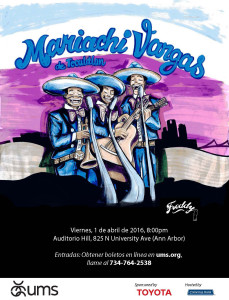A Mariachi Celebration In Southeast Michigan
Take a look back at an unforgettable week of celebration in Ann Arbor, Flint, and Detroit, featuring the inspiring and award-winning students of Mariachi Nuevo Santander…
1. Champion Musicians Head to Ann Arbor
Last December, the incredibly talented young musicians from Mariachi Nuevo Santander of Roma, TX won the 2019 National Mariachi High School Group Competition at the Mariachi Vargas Extravaganza in San Antonio. This prize also earned them a trip to Ann Arbor courtesy of the University of Michigan Office of Diversity, Equity and Inclusion, to perform as an opening act for Mariachi Vargas de Tecalitlán and participate in meaningful community and engagement activities.

2. An In-School Cultural Learning Experience
For five weeks leading up to Mariachi Vargas’s School Day Performance, UMS partnered with Ann Arbor’s Scarlett Middle School to design a full interdisciplinary unit about mariachi music. Alongside learning about the history and culture of the Mexican tradition, students designed and painted a special mural with Elton Monroy Duran, a UMS teaching artist and Mexican-American muralist whose work can be seen throughout Southwest Detroit.

3. ‘Engaging Performance’ Class at U-M
Mariachi Nuevo Santander led a discussion of mariachi music and its significance in Mexican culture with the “Engaging Performance” class at U-M. UMS offers this class each winter semester in collaboration with the College of Literature, Science, and the Arts and the School of Music, Theatre & Dance.

4. Visit to Flint, MI
After “Engaging Performance,” the group headed up to Flint, MI, giving a family-friendly mini-performance at Educare Flint thanks to a partnership with Michigan Medicine and Hurley Children’s Hospital. They also participated in a performance exchange and dinner with members from El Ballet Folklórico Estudiantil and UM-Flint’s Music Department and Latin American Student Association.

5. Southwest Detroit Community Dinner
Mariachi Nuevo Santander spent a fun day enjoying the sights and sounds of Detroit and joined Ballet Folklórico de Detroit in performance at a dinner hosted by UMS for community members of Southwest Detroit and participants from Living Arts Detroit.

6. School Day Performance in Hill Auditorium
Special guests Mariachi Nuevo Santander joined the world-renowned Mariachi Vargas de Tecalitlán for a packed School Day Performance at Hill Auditorium!

In total, more than 3,000 K-12 students from 28 schools across Southeast Michigan attended.

7. U-M Student Dinner
Catalina Ormsby, U-M Associate Director for the Center for Educational Outreach, introduced the Michigan experience to Mariachi Nuevo Santander, who met with representatives from Latinx student organizations across campus (La Casa, Corazones Unidos Siempre, Chi Upsilon Sigma, Lambda Theta Phi, Latin Fraternity, Inc., and Center for Latin American and Caribbean Studies).

8. Final Goodbye at Scarlett Middle School…
Celebrating the conclusion of their six-week immersive curriculum, students of Scarlett Middle School participated in workshops with members of Mariachi Nuevo Santander.
At the end of a school-wide assembly and performance by more than 300 kids, Scarlett Middle School Principal Gerald Vazquez reinforced that Scarlett is a safe space for all students — that “you, this generation of diverse students, are what makes America great.”
9. …And an Encore at UMMA
Before taking off for their flight back to Texas, Mariachi Nuevo Santander gave a free pop-up performance at the University of Michigan Museum of Art.

A special thank you to our sponsors and to all those who invest in UMS with an annual gift — making it possible for us to bring immersive learning opportunities beyond the stage for students throughout Southeast Michigan each season.
U-M student sings Mariachi song
University of Michigan student Christina Maxwell sings Mariachi song “Besame Mucho.” She learned this and so much more as part of her multi-week internship experience with Mariachi Vargas de Tecalitlán.
Masks at Southwest Detroit Immersion

As part of a day-long Southwest Detroit Mexican Arts & Culture immersion, teachers created masks at the Detroit Institute of Arts. We’re getting ready for Mariachi Vargas de Tecalitlán on April 1, 2016.
Community Spotlight: Muralist Freddy Diaz
Southwest Detroit mural artist Freddy Diaz designed a special poster for the Mariachi Vargas de Tecalitlán performance. We chatted with Diaz about starting out with graffiti, living in Southwest Detroit, and Mariachi music.
UMS: How long you’ve been working on murals?
Freddy Diaz: I want to say maybe a good four years now. My introduction into doing murals was graffiti. I grew up in Southwest all my life and came out of the Detroit Public Schools program. People were still very ‘90s when I was growing up, and even then technology wasn’t super up yet, and everybody rode bikes, and there was a bit of gang stuff, but it was either graffiti or gangs. And I always chose graffiti. I liked the art and colors, and it drew me in a lot closer than doing anything negative.
So, I started doing graffiti when I was 12-13 years old, and then as I got older and gained a bit more consciousness about what to do with my art, I started to reach out to local businesses in the neighborhood. That gave me an opportunity to work with business owners, and they gave me advice about how to adjust, how to run my own business. So I would say that I got legit about three-four years ago, and I’ve been at it ever since.
UMS: Were you part of an arts program at DPS, or was this more of a hobby?
FD: It was a hobby from a culture that started before I was born. Detroit has a graffiti culture that probably started in the late ’80 or early ‘90s, and then just followed through generations.
I think that’s what I like about Southwest is that Southwest is really active as far as culture. The majority of Southwest is Mexican, but there are areas where there’s a lot of Arabic culture, areas where there’s Cuban, Puerto-Rican. It’s really cool because you get a bit of everything.
UMS: We’re talking in part because you did this special poster promoting the Mariachi Vargas performance. Has Mariachi music has played a role in your own life?
FD: I would honestly say that I did overlook it when I was younger because it’s just always been around us. When you do go to Mexico, everywhere there is a plaza where on a Sunday night there are Mariachi playing. You take your girlfriend on a walk, stroll through the park at night, and there are just bands. There are people selling food, or people just singing. So I’ve always had it around since I was a kid.
When I was working on the poster, I was thinking more about the vibe that people get from Mariachi music, and I kind of wanted to give people that same feeling.
I did tell my parents about this poster, and they ended up telling me that Vargas are the top Mariachis in the world.
I was like, “Yes, mom, I’ve been doing this Mariachi poster for UMS,” and they’re like, “Really? What’s the name of them?” And I was like, “You know Vargas-something,” and she just finished the name—[laughs] and I was like, “Yes!” and she was like, “No way, show me.” So I pulled out the email, and she reads it and says, “You know they’re like the best in the world, right?”
That got me freaking out, I was like, “Really?” I kind of felt embarrassed because I didn’t know, and I think that it was better that way because if I knew, it would’ve been overwhelming. Not knowing the whole time let me have more fun with it.
See the Mariachi Vargas de Tecalitlán in Ann Arbor on April 1, 2016.
Student Spotlight: Embedded with Mariachi Vargas
Editor’s note: As part of the UMS 21st Century Artist Internships program, four students interned for a minimum of five weeks with a dance, theater, or music ensemble part of our 2015-2016 season. Christina Maxwell is one of these students. This summer, she was embedded with the Mariachi Vargas de Tecalitlán.
Below, Christina shares her travel stories in advance of their return Ann Arbor on April 1, 2015.
As the plane prepares for takeoff, I put down the notebook of Spanish verb conjugations I’ve been feverishly trying to memorize. I found out only a week ago that I’d been selected to spend the summer working with Mariachi Vargas de Tecalitlán, the world’s premier Mariachi group based out of Mexico. So only a few days and 150 pounds of luggage later, I’m on my way to San Antonio, Texas.
Mariachi Vargas was founded in 1897 in Jalisco, Mexico and consists of 13 electrically dynamic men on vocals, guitar, guitarrón, violin, vihuela, trumpet, and harp. I will work with Muñoz Public Relations, the agency that will present Mariachi Vargas in Ann Arbor in April. I wonder what in the world I, a Southern, white Musical Theatre major and writing minor with a minimal Spanish vocabulary and almost no exposure to Mariachi music, am doing on this airplane. For me, and perhaps for many readers here on UMS Lobby, my only exposure to Mariachi Music has been the familiar selections that might be heard at a Mexican restaurant.
What did I have to offer to these people? A million doubts materialized as the barometric pressure rose, and as San Antonio and the hazy world of Mariachi Music crept closer. This is when I remind myself that that feeling of free-falling, of having no idea what lies ahead or whether I have what it takes to embrace it, usually comes before the greatest adventures. And a great adventure it was.
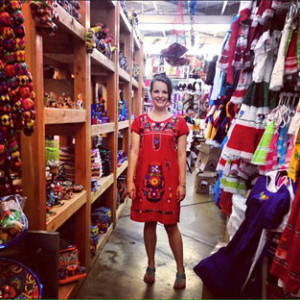
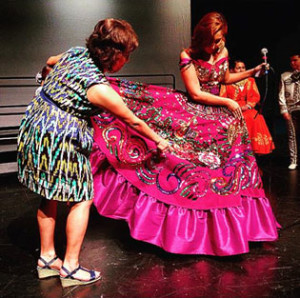
On left, the traditional huipil I bought in the San Antonio Market Square. On right, Cynthia shows the intricate details of a student’s dress during a traje presentation (the traditional attire for Mariachi singers).
Settling into San Antonio
I remember this summer as an explosion of color, flavor, and sound. There is nothing black-and-white about the world of Mariachi Music and the Mexicano community that embraces it as lifeblood. The crowded streets of the San Antonio Market Square are flooded with vibrant fabrics and rich fragrances drifting from street food stands selling elotes (roasted corn), mangonadas (a Mexican fruit drink), and fresh fruit with lime and chili powder. Rainbows of dazzling sequins and threads decorate the intricate and costly trajes and sombreros of the Mariachi performers. Even sunlight seems more alive as it sparkles through the stained glass windows of the nearby ancient Espada Mission. Everything is full of rhythm and life and everything is done to the fullest…whether that’s mourning heartache, celebrating with tequila, or extending hospitality.
The Mariachi community did not merely accept me. They welcomed me, a stranger, into their world with open arms. I worked for Cynthia Muñoz, a brilliant woman who runs her own agency, Muñoz Public Relations, with her sister, Sandra Guevara. A savvy, creative and passionate businesswoman, Cynthia landed the coveted Ford Motor Company account in 1992. Cynthia has combined her brilliant business sense with her long-time love for Mariachi music to resurrect and preserve the tradition of Mariachi music in San Antonio.
She produces concerts in the US by the world-renowned group Mariachi Vargas de Tecalitlán (like their upcoming April performance in Hill Auditorium in Ann Arbor, Michigan). In 1995, she began the Mariachi Vargas Extravaganza, the longest-running Mariachi music festival in Texas. The festival is a bedrock for cultural diversity in the arts, and for the importance of education in the Mexican American community. It’s become an integral part of the San Antonio community, which is part of the reason why Cynthia was recently awarded the San Antonio Business Journal’s “Woman of the Year” award.
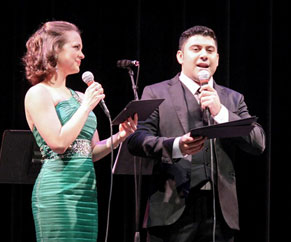
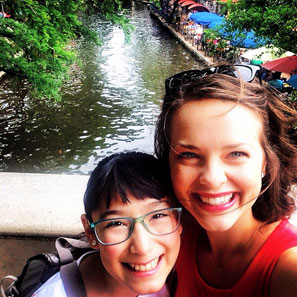
On left, with my fellow emcee Elio Iniguez during the Serenata Para Las. Madres. When we were offstage, Elio translated every word of the music for me so I could truly understand it. On right, enjoying the famous River Walk with the extraordinarily talented and bilingual Angelica Vargas.
Settling into the internship
I watched Cynthia network with ease and acumen, garner the attention of the press with persistence and a personal touch, and whip up a perfectly worded and irresistible corporate sponsorship package in the middle of the night over ice cream sundaes. She entrusted me with a full gamut of tasks, from writing and submitting press releases to finding and contacting booking houses across the country. In my first week in San Antonio, I worked to help Cynthia produce, execute, stage, organize, market and even emcee Serenata Para Las Madres, a Mother’s Day event in a beautiful old theater in downtown San Antonio. I also worked extensively with and accompanied Angelica Vargas, a young star from Mexico.
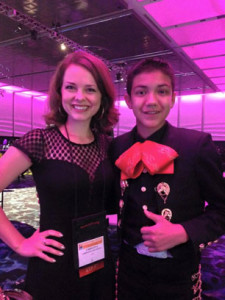
Photo: With Sebastian de la Cruz at La Raza. Sebastian performed with Mariachi Vargas de Tecalitlán the first time they visited Ann Arbor, Michigan. Most recently, ESPN did a special documentary on Sebastian, produced and directed by Eva Longoria. He was also featured on an episode of The Bachelor this summer, which we all watched from San Antonio!
Even after my internship ended, Cynthia hired me to help produce a high-profile event in Kansas City for La Raza, the largest Spanish convention in the country which features guest speakers like Hilary Clinton. I worked sound, lights, production and talent management under the highest of stakes for a concert featuring Pedro Fernandez, perhaps the most famous star of Mexico. I spent time with some of the hottest young talent, including Sebastian de la Cruz, an immensely talented Mexican-American San Antonio native. Sebastian is famous for competing on America’s Got Talent and for weathering racist remarks with class and bravery when he sang the National Anthem at an NBA Finals game at only eleven. The range of experiences she gave me was truly remarkable.
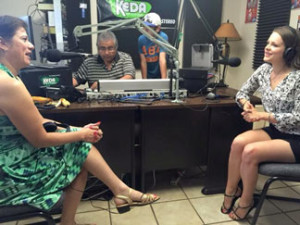
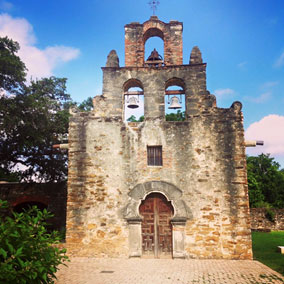
On left, sharing my experiences as a gringa in San Antonio on Cynthia’s morning talk show on KEDA Radio. My family from all over the South was able to tune in and listen! On right, the hauntingly beautiful Mission San Fransisco de la Espada, built in 1690, is one of the many missions Cynthia and I cycled to. The San Antonio missions were declared a World Heritage Sight while I was there this summer.
Living and working to the fullest
With true Mariachi hospitality, Cynthia welcomed me, a complete stranger, into her home for the duration of my stay. She lives with an ever-fluctuating balance between work and play, working when and how she wants and enjoying each day to the fullest. Each morning, we woke, ate a fresh and flavorful home-cooked breakfast, found a trendy local coffee shop to try, cycled for two hours along the River Walk or on the Mission Trail through the morning sunlight, and then come back to work late into the night. We’d finish the day with several episodes of Pablo Escobar, a Spanish novella-style series about the infamous Columbian drug lord, complete with subtitles to help me with my Spanish.
Cynthia’s sister, Sandra, is the tireless force that keeps the operation running. She’s a stickler for details and an expert in logistics, scheduling, and where to find the best piña coladas. Sandra taught me how to chase down bicycle street vendors for a pelota (a delicious popsicle with fruit and condensed milk), to manage the logistics for events with swarms of children, and to rally for all-nighters of celebrating with the members of Mariachi Vargas, playing music, laughing and telling stories into the early morning. Their entire family and business welcomed me into the fold, each teaching me something different. Sandra’s son, Javier, visited from New York and showed me around San Antonio from the eyes of someone close to my age, exposing me to San Antionio’s best sushi and to the view of Mariachi Music from behind his camera lens. I became dear friends with a fellow intern, Samantha, through our shared love for music, late nights talking, and shopping for turquoise in the downtown market. A former employee and family friend Laura and I bonded instantly over the chaos of working backstage and the beauty and intrigue of the Mariachi world. And Cynthia’s niece Haidyshared margaritas with me, helped me with my Spanish, and offered hilarious insider details to the Mariachi world. I found myself so quickly surrounded by new friends who I truly believe I’ll always stay in touch with.
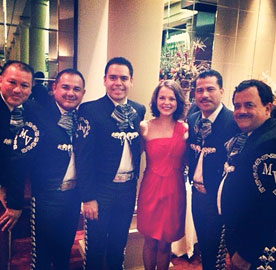
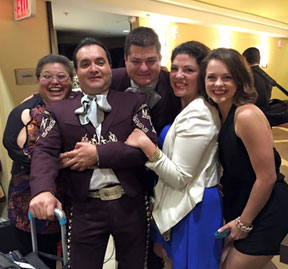
On left, meeting members of Mariachi Vargas for the first time after seeing them perform in the new opera, El Pasado Nunca Se Termina, at the Houston Grand Opera. On right, with Sandra and their employee and my new friend, Laura, welcoming members of Mariachi Vargas back after their phenomenal performance in Albuquerque, New Mexico.
Preparing for vocal camp
For the majority of the summer, I worked with Cynthia, Sandra, and other interns and staff members to prepare for the annual Mariachi Extravaganza Summer Vocal Camp. Nearly sixty of the most promising young Mariachi artists ranging in ages from 10 to 18 came to San Antonio from 20 cities across the US to work with extraordinary teachers to perfect their technique and stage presence. I helped to prepare the camp and knew everything about the students before they arrived, having created orientation packets and curriculum guides, arranged schedules for instructors, and sent numerous press releases.
Little did I know that I had much more than behind-the-scenes work in store. Cynthia asked me to workshop stage presence and confidence with the kids (she knew about my Musical Theatre background and had seen several videos of my performances). This was meant to happen after I observed the other instructors. On the way to camp the first day, she said, “Oh, by the way, two of today’s guest instructors can’t make it. You’ll have the 60 kids for two hours. Can you handle that?” Inside I panicked, thinking, “You’re kidding right?” But I smiled and heard myself say, “Ya, no problem!”
As looked at these 60 adorable and insanely talented kids, I felt the same doubt I had felt on the airplane. Yet, after the first student sang, I knew how much we all had in common. We all loved getting inside a song as a vehicle for the things we can’t put words to. We shared a deep respect for the history and integrity of music and for understanding where it comes from. I saw in those kids a hunger to learn, to grow and to better understand…the same exact thing I feel in myself every day as a student at the University of Michigan.
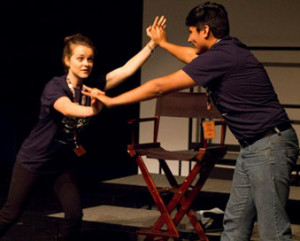
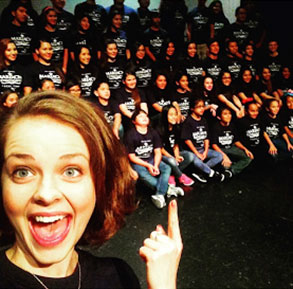
On left, working on confidence-building exercises with a student. On right, selfie time with 60 of the most talented and eager children I’ve met!
Singing in color
So, I stole from one of my favorite professors at the University of Michigan and taught them what I’d learned in a class called “Sophomore Performance.” How to truly communicate. The students wrote lyrics as a way to communicate with someone they knew, a conversation. We played silly games to loosen up and engage our bodies. We talked to each other as scene partners. They said their names about a zillion times until they could do it with confidence, clarity, and pride.
I watched the students learn with remarkable speed, excitement, and dedication. I saw light bulbs come on as they worked on communicating the high-stakes meaning of a song. I found myself loving teaching! One student jumped up and down after his individual lesson and said, “Woah. I’m gonna cry! Like when you were talking to me, I was so connected that I could feel it.” Another finished her heartbreaking rendition of a song after I worked with her and said, “I feel like everything just changed for me. Like my whole life I’ve been singing in black and white and suddenly I’m singing in color.”
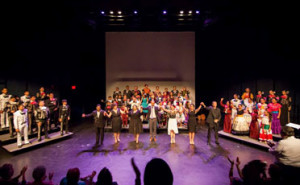
Taking a final bow with students and instructors, including Octavio Moreno, Vanessa Cerda Alonzo, and fellow intern and dear friend, Samantha Arizpe.
Taking a final bow with students and instructors, including immensely talented and beloved Octavio Moreno, Vanessa Cerda Alonzo, Rene Benavidez, and fellow intern and dear friend, Samantha Arizpe.
I can’t explain the pride and love I felt for my students as I watched them bare their souls through song, dressed in stunning traditional trajes. One of our students who had struggled to say his name with confidence at the beginning but who delivered such a powerful performance hugged me so tightly after the recital that I could hardly breathe. He said over and over, “Thank you, miss! Thank you, miss! Please don’t leave us! You’ll never understand what you’ve done for me!”
But the truth is, they’d done so much for me. They’d helped me to truly understand how deeply Mariachi music can move someone. They’d explained what Mariachi music means to them, how it “felt like freedom” or that it was like “when you have something stuck deep inside of you, and then you sing, and you can let it out.” Mariachi is something “the whole world should know about, so that they can love it, too.” I watched what these little Mariachi singers did for the people in the audience. I saw as these children’s families beamed with pride and cried out of love as they saw their children pour their hearts out through the musical tradition that had fed their own souls and the souls of their parents and grandparents and great grandparents for decades.

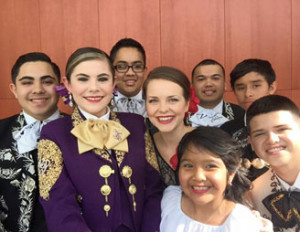
On left, at Cynthia’s request, I sang “Over the Rainbow” at the end of the recital as a way of sharing my own music from the world I come from. On right, with a group of the students, celebrating their success throughout the week!
“Have you ever seen people watch Mariachi Vargas perform? Look at them and then you will understand.”
But teaching was not without difficulty. There were times when I wasn’t sure what my role was or whether my advice was clashing with the form of music I was still learning about. At one point, Mr. Muñoz, Cynthia’s father, and her aunt pulled me aside after I worked with one of the students on how to push through the emotion of a song so that you don’t get too choked up to sing it. They said, “We think what you said to her isn’t right. You are here to teach, but you are also here to learn. And you don’t understand our world yet. What she did, she moved us so deeply because the people of our generation, we feel it. It’s when we see her cry that we break too.” At first, my heart sank. The last thing I wanted to do was to show ignorance, disrespect, or distaste for the culture and tradition. They continued, “Have you ever seen people watch Mariachi Vargas perform? Look at them and then you will understand.”
So when I went to Albuquerque, New Mexico with Cynthia, Sandra and close friend and co-worker Laura for a huge Mariachi Vargas concert, I did just that.
I sat in the middle of the Albuquerque, New Mexico mountains and watched the world’s three greatest Mariachi groups perform back to back, with Mariachi Vargas de Tecalitlán as the finale. I was completely captivated and breathless from the roller coaster of emotions I felt (during music that was not even in my own language!) The sky faded from blue to warm orange, red and purple, to deep black. Dust and strings flew from passionately flying guitar bows and bellows, cries, whispers and sighs cut from the mouths of the passionate performers straight to my soul. I sat captivated by their electric performance, a performance that used century-old music in a language I only intermittently understood to fill me with joy, mourning, longing, and celebratory abandonment.
When Mariachi Vargas de Tecalitlán began to play, I watched as the people around me cheered, held each other and mouthed the words along with them, as if the lyrics and the notes poured from a deep place within their souls, a place that we normally don’t bare. Mariachi music has a way of going to those places and living in them, awakening feelings that maybe we don’t often allow ourselves to feel. People were so moved that they wept openly. When the concert ended, I picked my phone up again for the first time since the concert began and realized that the concert had lasted five hours. I hadn’t considered that passage of time, or anything else outside of the performance.
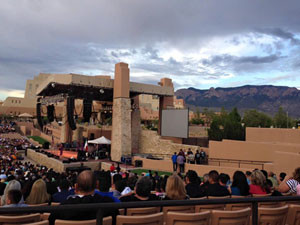
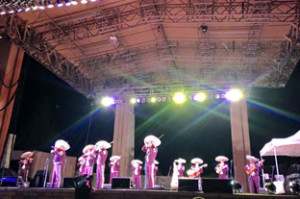
On left, getting ready for the concert to begin in Albuquerque! A breathtaking venue. On right, Mariachi Vargas take the stage!In video below, singing “Besame Mucho.”
When I think of that moment and compare it with what so many of us perceive Mariachi music to be, I realize what a chasm there is between the two. I saw the same reverence for the music when I learned “Besame Mucho,” a beautiful song in Spanish, and had the opportunity to work with Rigoberto Alfaro, a member and arranger for Mariachi Vargas for 13 years, and also one of the most instrumental figures in the history of Mariachi music. He offered to “lesson me,” to share his wisdom with me. As he played the guitar, I sang “Besame Mucho” while he motioned for me to give it more passion and instructed me to “sing it as I feel it.” That is where it comes from. It’s not about performing, it’s about understanding the depth and history of what you’re singing and allowing the feeling to sweep you along.
During the performance in Albuquerque, Mariachi Vargas member, José “Pepe” Martínez Jr. went into the crowd to serenade a few ladies, and I was lucky enough to make the cut.
Understanding the depth of history
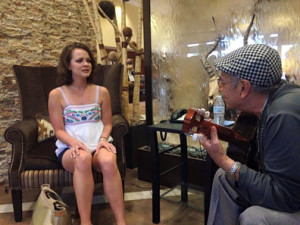
Working with the maestro himself, Rigoberto Alfonso. I still can’t believe I had the opportunity to be coached by the master himself!
I finally understood. And I wanted to learn more from the generation of people who so deeply valued and fiercely guarded the history of the music. So I listened to old recordings of the classics, listened to Cynthia’s friend, Rene, played the guitar with devotion, talked with reverence about Mariachi music, and observed the brilliant instruction, performances and meticulous dedication and heart of my extraordinary fellow instructors, Octavio Moreno and Vanessa Cerda Alonzo. I spent many hours at the home of Cynthia’s parents, sharing meals, black-and-white photos, and taking cooking lessons with her mother. One night, I went to just listen. I sat down with Mr. Muñoz and listened as he told me about his life, about the world he came from. He sat with his hands folded, proudly wearing a Korean War Veteran hat. I watched the deep lines in his face move as he told me about the tiny town in Texas where he grew up. It was so deeply segregated that the people, the whites and then the “Mexicans,” were divided in homes on opposite sides of the railroad tracks that ran through the town. He went to a completely segregated school for “Mexicans” (even though they were Mexican Americans) where the children spoke little or no English and the teachers spoke no Spanish. He explained to me that people of my generation don’t understand because we didn’t face what he did…the discrimination and the insurmountable odds.
I could not imagine his world of struggle until he told me one story in particular. Nearly fifty years ago, he and his brother loaded up their two station wagons with their wives and little kids to drive to Florida. They had been driving all day long when they stopped in Mississippi to find a place to rest for the night. The first place they went to, they were told there were no vacancies. They started again. The second one, the third one, the fourth one…the same thing happened. They came to the fifth place, and Mr. Muñoz stopped the owner before he could answer. He said, “Please don’t tell me you have no vacancy.” I waited quietly as he paused to clear his throat and regain composure. He continued, “My brother and I were standing there…we had to do that in front of our families?” This final man at the fifth place did welcome them and apologized for what the four other places had done. “You see, those are just minor things that our people have gone through.”
But when he talks about how proud he is of what his kids, Cynthia and Sandra, have done and of all he hopes for his grandchildren, the light returns to his eyes. He talks about how education is the way forward, the only way to move on. As he talks about music. I think of the students I taught. “Music is not something we hear for entertainment. This type of music or cohunta music or even guitar music…it’s our life, it’s part of our life, part of our existence.”
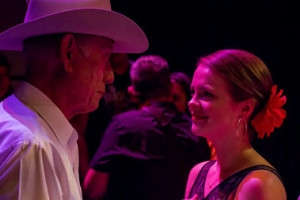
A final moment with Mr. Muñoz. Here, he told me I was now a part of the Mariachi Family.
Now, I’m not the same girl who boarded that airplane to San Antonio. This girl knows how to say “adios” with the correct nuance that makes you sound like a local rather than a gringa. I know how to cook traditional chicken mole and how to do the steps to the meringue dance.
Most importantly, I know that Mariachi music is a rich, vibrant, and thriving art form that cannot be fully understood until you see the faces of the people in the audience, the way they fill up with the celebration, love, and pain found in the songs themselves, the feelings that have poured into Mariachi music for over a century. This girl needed to learn these things, to go from that feeling of free-falling to that feeling of belonging to a new family, a Mariachi family. In my final conversation with Mr. Muñoz, he told me that Cynthia needed me… just the way that I came to San Antonio because I needed Cynthia. He was right. I needed to learn. Not only to sing, to mourn, to celebrate, to listen… but to live.
The Mariachi Vargas de Tecalitlán return to Ann Arbor April 1, 2015
Interested in more? Explore our photo and audio tour of Detroit’s Mexican Town.
Photo and Audio Tour of Detroit’s Mexicantown
Editor’s note: The Mariachi Vargas de Tecalitlán return to Ann Arbor on April 1, 2016.
Mariachi Vargas is one of the most highly regarded ensembles in the history of mariachi. Founded in a small city near Jalisco by Don Gaspar Vargas in the 1890s, this band basically invented the modern mariachi, and five generations later, is still playing today.
To explore the music’s connection to our community, we asked WDET’s Martina Guzmán to give us a tour of Detroit’s Mexicantown, a neighborhood with over 100 years of history in the city. Check out the tour below, with images by Detroit-based photographer Erik Howard.
We also visited the LA SED (Latin Americans for Social and Economic Development) Senior Center in the neighborhood, where we heard many stories about the community importance of mariachi music.

“I was born and raised through Mariachis,” Lupe Guzmán says. “Don’t believe what I say, but Mariachi music is like medicine. Mariachi…you have one on side and another Mariachi on the other side, and they make you alive.”

Beatrice Gonzales was a singer when she was younger. She bought the dress in this photo in Mexico 35 years ago. She says that she is still in love with the tradition of Mariachis.

Arnulfo Guiterrez’ favorite song is “El Mariachi Loco.” It’s a LA SED Senior Center favorite for dancing.

UMS thanks AARP for coordinating ticketing and transportation for a group of LA SED seniors to attend the Mariachi Vargas de Tecalitlán performance.
Video: Behind the scenes with Mariachi Vargas at WDET Detroit
Here’s a special behind-the-scenes video of the Mariachi Vargas de Tecalitlan artist residency. Yesterday, Alberto Alfaro (violinist in Mariachi Vargas) accompanied two youth Mariachi singers, Sebastien de la Cruz and Karenn Lazo (both were winners in the 2009 Mariachi Vargas Extravaganza Competition) on the Craig Fahle radio show on WDET 101.9 FM Detroit. Sebastien and Karenn will sing this morning at Hil Auditorium in a special youth performance for K-12 students from Southeastern Michigan. I highly recommend scanning forward to about 1:30 in the video to hear Sebastien sing — he’s amazing! Also, don’t miss Karenn’s performance at the end of the video, which is equally stunning.
Additional UMS 10/11 Events
UMS is pleased to announce additional concerts in the 10/11 season that are not part of our genre-specific packages. These events are all part of UMS’s popular Monogram Series, which allows audience members to select at least five events and receive a 10% discount.
Rosanne Cash: The List
Saturday, September 25 | 8 pm
Hill Auditorium
When Roseanne Cash was 18 and on the road with her father, the incomparable country music superstar Johnny Cash, he became alarmed at the number of songs that she didn’t know. As the tour progressed, he developed a list on a legal pad — “100 Essential Country Songs” — and gave it to her with a thinly veiled admonishment that she needed to do her homework. Now, more than 30 years later, Cash has selected a dozen songs from the syllabus presented to her by her father and has recorded her first album of covers, filtered through her own unique, sophisticated perspective. The List presents Roseanne Cash like you’ve never heard her before, as she embraces her heritage and sings for the pure love of these songs that have shaped who she is as an artist.
Mariachi Vargas de Tecalitlán
Saturday, November 6 | 8 pm
Hill Auditorium
With a history that dates back to the late 1890s, the Mariachi Vargas de Tecalitlán was founded in a small city near Jalisco by Don Gaspar Vargas. This band basically invented the modern mariachi, and five generations later, are still playing today. The group spent its formative years defining their sound and experimenting with different instrumental lineups. Today the group is comprised of two harps, one vihuela, one guitar, one guitarron, two trumpets, and six violins. The songs they sing cross over from one generation to the next, making their performances appealing to both young and mature audiences. Recognized as “el major mariachi del mundo” (the greatest mariachi in the world), Mariachi Vargas are the masters at melding the old world style of mariachi music with new innovative pieces.
Stew and The Negro Problem
with Heidi Rodewald
Thursday, November 18 | 8 pm
Friday, November 19 | 8 pm
Saturday, November 20 | 7:30 pm & 10:30 pm
Location TBA
“Stew’s endlessly inventive music draws on rock, gospel, soul, and blues…A winning tribute to the diversity of the black musical experience.” (Hollywood Reporter) Songwriter Stew’s career took an unexpected turn in 2006. After a successful career fronting his critically acclaimed bands, Stew and The Negro Problem, he transformed his life story into the rock musical Passing Strange. The show, co-composed with Heidi Rodewald, earned him the 2008 Tony Award for “Best Book of a Musical” and attracted the attention of Spike Lee, who produced the film, which premiered at the 2009 Sundance Film Festival and airs on PBS’s “Great Performances.” Compared in the same breath with Kurt Weill, Burt Bacharach, and Jackie Gleason, Stew’s concert performances are coveted for their literate precision, sly humor, and deep emotional resonance, hovering between the divergent worlds of rock and theater. “Something hipper for the hipper…Stew is a very genial and lovable guide through the common travails of life. Like a lot of fine writers and musicians, he has the ability to layer reflexive self-doubt into his music and lyrics…very witty, very smart.” (Chicago Tribune)
Carolina Chocolate Drops
Friday, December 3 | 8 pm
Michigan Theater
“Tradition is a guide, not a jailer. We play in an older tradition but we are modern musicians,” says Justin Robinson, a member of the popular bluegrass band, the Carolina Chocolate Drops. The group’s name is a tip of the hat to the Tennessee Chocolate Drops, who lit up the music scene in the 1930s. Inspired by old-time fiddler Joe Thompson, at whose home they jammed every Thursday night during the summer and fall of 2005, the CCD starting playing anywhere people would listen — town squares, farmers’ markets, and ultimately festivals and concert halls, where their foot-tapping music linked the deep tradition of the past with “dirt-floor-dance electricity.” (Rolling Stone) Their sellout shows at the Ark last year reinforced how far they’ve come in a very short time. “This striking North Carolina trio brings a modern sizzle to the legacy of classic African American stringbands…sparking an electrifying ruckus.” (Spin)
Handel’s Messiah
Ann Arbor Symphony Orchestra and UMS Choral Union
Jerry Blackstone conductor
Saturday, December 4 | 8 pm
Sunday, December 5 | 2 pm
Hill Auditorium
The Grammy Award-winning UMS Choral Union (2006 Best Choral Performance for William Bolcom’s Songs of Innocence and of Experience) launches the holiday season with its signature work, Handel’s glorious oratorio Messiah. An Ann Arbor tradition in the beautiful surroundings of Hill Auditorium, these performances are ultimately the heart and soul of UMS, connecting audiences with the talented people on stage, but also with the friends and family who attend each year. Those who have been coming for decades say that the chorus has never sounded better.
Joanne Shenandoah
Sunday, January 23 | 4 pm
Rackham Auditorium
One of today’s most revered Native American singers and songwriters, Joanne Shenandoah is a Wolf Clan member of the Iroqois Confederacy, Oneida Nation whose Native name, Deguiya whah-wa, means “she sings.” The singer/songwriter has performed with such legendary entertainers as Kris Kristofferson and Willie Nelson and has won more Native American Music Awards (Nammies) than any other artist. The daughter of two talented musicians (her father, a jazz guitarist, played with Duke Ellington), Shenandoah was an architectural systems engineer before forging her successful career as a musician. “From my office window I saw a tree being cut down and knew that I, too, had been uprooted and needed to follow my natural gift,” she says. Shenandoah’s original compositions, combined with a striking voice, enable her to embellish the ancient songs of the Iroquois using a blend of traditional and contemporary instrumentation.
Blues at the Crossroads: The Robert Johnson Centennial Concert
featuring Big Head Todd & The Monsters
David “Honeyboy” Edwards
Hubert Sumlin
Cedric Burnside
and Lightnin’ Malcolm
Thursday, February 10 | 8 pm
Hill Auditorium
Straight from the heart of the back country, Blues at the Crossroads has a direct connection back to Robert Johnson (1911-1938), among the most famous of Delta blues musicians. Johnson’s landmark recordings in the 1930s displayed a remarkable combination of singing, miraculous guitar skills, and songwriting talent that have influenced generations of musicians, including Eric Clapton, who called him “the most important blues singer that ever lived.” This concert picks up the thread of Johnson’s legacy in Mississippi at the junction of US Highways 61 and 49, the very crossroads where, as legend has it, Robert Johnson made a deal with the devil, giving up his soul to write the most incredible blues the world had ever heard. The concert features Big Head Todd & The Monsters, as well as David “Honeyboy” Edwards, who at 94 is the only living person to have played with Robert Johnson before his untimely death at age 27 — believed to have been caused by poisoning from a bottle of whiskey that was laced with strychnine.
Kodo Drummers
Wednesday, February 23 | 8 pm
Hill Auditorium
In ancient Japan, the taiko drum was a symbol of the rural community, and it is said that the limits of the village were defined not by geography, but by the furthest distance from which the taiko could be heard. With its “One Earth” tour, Kodo brings the sound of the taiko to people around the globe, transcending barriers of language and custom and reminding all of our membership in that much larger community, the world. “In this age of exploding populations and lightning-fast communication, it is more important than ever that these diverse cultures learn to recognize and accept each other so that all may share our increasingly shrinking planet in harmony,” according to Kodo’s primary philosophy. The Japanese characters of the company’s name convey two meanings: “heartbeat,” the primal source of all rhythm, and “children of the drum,” a reflection of Kodo’s desire to play their drums simply, with the heart of a child.
Tony Allen’s Secret Agent
Saturday, April 16 | 8 pm
Hill Auditorium
The drummer behind the late Nigerian bandleader Fela Anikulapo Kuti, Tony Allen is probably the most highly-regarded African drum set player to emerge since World War II, with drummers and other musicians of all backgrounds marveling at his polyrhythmic style. Kuti is largely considered the most influential African popular musician of the post-colonial era, and Tony Allen was his crucial collaborator in the synthesis of jazz, funk, and highlife that resulted in the style known as Afrobeat.Born in Nigeria in 1940 of mixed Nigerian and Ghanaian parentage, Allen is influenced by everything from European ballroom dance music to big-band jazz drumming, indigenous percussion traditions, and the tradition of modern jazz drumming typified by such musicians as Art Blakey, Elvin Jones, and Max Roach. After playing for years in the shadows of better-known musicians, Tony Allen is now starting to receive the worldwide credit he deserves as one of the most dynamic players of the drum set. “Without Tony, there’d be no Afrobeat.” (Fela Anikulapo Kuti)
Other events on the Monogram Series:
Paul Taylor Dance Company
Sankai Juku: Hibiki
Grupo Corpo
Merce Cunningham Dance Company
The Hot Club of San Francisco and the Hot Club of Detroit/Django Reinhardt 100th Birthday Celebration
Wynton Marsalis and Jazz at Lincoln Center Orchestra
Vijay Iyer Trio and Rudresh Mahanthappa’s Apex
Septeto Nacional Ignacio Piñeiro de Cuba
Susurrus
Laurie Anderson’s Delusion
Druid Theater Company: Martin McDonagh’s The Cripple of Inishmaan
Propeller Theater Company: Shakespeare’s Richard III and The Comedy of Errors
Divine Voices (St. Francis of Assisi Catholic Church)
Jordi Savall and La Capella Reial de Catalunya with Hesperion XXI and Temembe Ensamble
The Tallis Scholars
Sequentia
Jerusalem String Quartet
Nadja Salerno-Sonnenberg and New Century Chamber Orchestra
Concertante and Rafał Blechacz, piano
Takács Quartet: Schubert Concert 2
Takács Quartet: Schubert Concert 3
Tetzlaff Quartet
Venice Baroque Orchestra
The Cleveland Orchestra
Rafał Blechacz, piano
Detroit Symphony Orchestra/Mahler’s Symphony No. 8
Bach Collegium Japan/Bach’s Mass in b minor
Liebeslieder Waltzes
******************************************
GLOBAL FOCUS ON THE AMERICAS
******************************************
This season’s global series explores The Americas — North, South, and Latin — with 19 different events representing something uniquely different about this part of the world. The events featured on The Americas series are:
Roseanne Cash (Sat Sep 25)
Tembembe Ensamble Continuo/The Route of the New World: From Spain to Mexico (Thu Sep 30)
Paul Taylor Dance Company (Thu-Sat Oct 7-9)
Venice Baroque Orchestra/Philip Glass’s “American Four Seasons” (Wed Oct 27)
ONCE.MORE Festival: The Historic Concert (Tue Nov 2)
Mariachi Vargas de Tecalitlán (Sat Nov 6)
Stew and The Negro Problem with Heidi Rodewald (Thu-Sat Nov 18-20)
Carolina Chocolate Drops (Fri Dec 3)
Laurie Anderson’s Delusion (Fri-Sat Jan 14-15)
Renée Fleming soprano (Sun Jan 16)
Grupo Corpo (Fri-Sat Jan 21-22)
Joanne Shenandoah (Sun Jan 23)
Baby Loves Salsa (family performances) (Sun Jan 30)
The Cleveland Orchestra (Tue Feb 1)
Wynton Marsalis and Jazz at Lincoln Center Orchestra (Wed Feb 2)
New Century Chamber Orchestra/Astor Piazzolla’s “Four Seasons of Buenos Aires” (Fri Feb 4)
Blues at the Crossroads: The Robert Johnson Centennial (Thu Feb 10)
Vijay Iyer Trio and Rudresh Mahanthappa’s Apex (Sat Feb 12)
Merce Cunningham Dance Company: The Legacy Project (Fri-Sat Feb 18-19)
Detroit Symphony Orchestra (Sat Mar 19)
Septeto Nacional Ignacio Piñeiro de Cuba (Thu Apr 7)
Tickets to individual events on the series go on sale on Monday, August 23 (via www.ums.org) and Wednesday, August 25 (in person and by phone).






